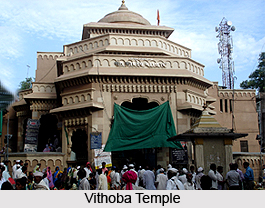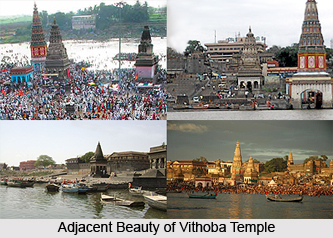 Vithoba temple in Pandharpur, Maharashtra was built on a small hillock at the foot of which runs a long lane known as Pradaksina Road. The eastern side has the main entrance of the temple, which faces river like in most temples. The Vithoba temple is not a consistent structure but a rather interesting gathering of shrines, halls and lodgings. The centre of it has the so-called Solakhandi hall and the garbhagriha of Vithoba with a small antechamber, on one side of which is the sejgliar, the `sleeping chamber` of the god. The idol of Vithoba stands alone in the inner shrine and the shrines of Rukmini and the other companions are consigned to the back wall of the temple.
Vithoba temple in Pandharpur, Maharashtra was built on a small hillock at the foot of which runs a long lane known as Pradaksina Road. The eastern side has the main entrance of the temple, which faces river like in most temples. The Vithoba temple is not a consistent structure but a rather interesting gathering of shrines, halls and lodgings. The centre of it has the so-called Solakhandi hall and the garbhagriha of Vithoba with a small antechamber, on one side of which is the sejgliar, the `sleeping chamber` of the god. The idol of Vithoba stands alone in the inner shrine and the shrines of Rukmini and the other companions are consigned to the back wall of the temple.
The image of Vithoba itself is made of black stone, which is about four feet high and roughly carved. This image signifies a rather plump boy with a large head with a Siva linga as his headgear. The image of Vithoba wears a thin dhoti on the loins, the Kaustubha mala around the neck and the Sri Vatsalanchan jewel on the chest. The large makara kundalas can be seen falling from the ear lobes down to the shoulders. In this image, the deity is shown having only two arms, where the left one holds a conch (shankha) and the right one holds a lotus stalk, two of Vishnu`s attributes. The two arms rest akimbo on the hips and the god stands perfectly erect and rigid. The two feet of the deity are joined on a square block said to be a `brick`, which is said to be the very brick Pundalik once threw at him. Here, one important thing should be noticed that the position of the feet is exactly that of a pair of `padukas` on a stone block, as worshipped from Buddhist times.
 But the arms are shown in more playful or even in dancing position. It is said to have resemblance with the initial position of the dancer as described in the Bharatnatyam.
But the arms are shown in more playful or even in dancing position. It is said to have resemblance with the initial position of the dancer as described in the Bharatnatyam.
The icon of Vithoba of Pandharpur is an exceptional one. The image here is clearly distinct from the usual representations of Lord Vishnu with four arms (usually flanked by two goddesses). Although the deity Vithoba is identified with Krishna Gopal, this god bears no similarity with the popular representations of this god as a flute player. The image in the main Vithoba temple at Pandharpur belongs to the sixth century AD. There is another Vithoba image found in another shrine of the same kshetra, which is known as Takpithya Vithoba. Some other images of Vithoba are found in a damaged state in the Elephanta caves and Kanheri caves, which belong to the eighth century AD. A lot of images of this deity were found in Karnataka also.
The Vithoba god in the posture with arms akimbo are comparatively rare in Vaisnava iconography but still some are found in the Udayagiri hills in Madhya Pradesh. But they have some dissimilarity also like the Udayagiri images have four arms, no `brick` pedestal and no linga as headdress. The linga headgear therefore could be a Marathi innovation.
There is said about two local images, one being in a small temple in the Thane district near Mumbai and the other image is found in the Archaeological Museum of St. Xavier`s College, Mumbai. The first image appears like a stone cylinder on which a head and two arms akimbo have been roughly carved. Here no legs are visible, as if the deity were simply growing out of the platform. The second one is a brass sculpture whose mukuta bears a linga and salunka.
It is assumed that the deity Vithoba may originally have been identical with the Jain Tirthankara Neminath or even with the Buddha but none of these appears very convincing. Again, a close link between the cult of Vithoba and that of Harihara, a divinity whose earliest representation is found at Badami is assumed. An image of Vithoba from Purandhara is listed in the catalogue of the Prince of Wales Museum in Mumbai. Here, the deity Vithoba has four arms, two of them more or less akimbo, the left part being Vishnu and the right Shiva. The joined feet on the square platform are stressed constantly in the abhariga literature. Here, it is taken as a sublime proof of Lord Vithoba`s total compliance to his devotees.





















